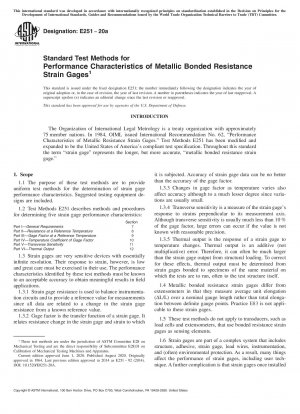ASTM E251-20a
Standard Test Methods for Performance Characteristics of Metallic Bonded Resistance Strain Gages
- Standard No.
- ASTM E251-20a
- Release Date
- 2020
- Published By
- American Society for Testing and Materials (ASTM)
- Latest
- ASTM E251-20a
- Scope
- 1.1 The purpose of these test methods are to provide uniform test methods for the determination of strain gage performance characteristics. Suggested testing equipment designs are included. 1.2 Test Methods E251 describes methods and procedures for determining five strain gage performance characteristics: Section Part I—General Requirements 7 Part II—Resistance at a Reference Temperature 8 Part III—Gage Factor at a Reference Temperature 9 Part IV—Temperature Coefficient of Gage Factor 10 Part V—Transverse Sensitivity 11 Part VI—Thermal Output 12 1.3 Strain gages are very sensitive devices with essentially infinite resolution. Their response to strain, however, is low and great care must be exercised in their use. The performance characteristics identified by these test methods must be known to an acceptable accuracy to obtain meaningful results in field applications. 1.3.1 Strain gage resistance is used to balance instrumentation circuits and to provide a reference value for measurements since all data are related to a change in the strain gage resistance from a known reference value. 1.3.2 Gage factor is the transfer function of a strain gage. It relates resistance change in the strain gage and strain to which it is subjected. Accuracy of strain gage data can be no better than the accuracy of the gage factor. 1.3.3 Changes in gage factor as temperature varies also affect accuracy although to a much lesser degree since variations are usually small. 1.3.4 Transverse sensitivity is a measure of the strain gage’s response to strains perpendicular to its measurement axis. Although transverse sensitivity is usually much less than 10 % of the gage factor, large errors can occur if the value is not known with reasonable precision. 1.3.5 Thermal output is the response of a strain gage to temperature changes. Thermal output is an additive (not multiplicative) error. Therefore, it can often be much larger than the strain gage output from structural loading. To correct for these effects, thermal output must be determined from strain gages bonded to specimens of the same material on which the tests are to run, often to the test structure itself. 1.4 Metallic bonded resistance strain gages differ from extensometers in that they measure average unit elongation (∆L/L) over a nominal gauge length rather than total elongation between definite gauge points. Practice E83 is not applicable to these strain gages. 1.5 These test methods do not apply to transducers, such as load cells and extensometers, that use bonded resistance strain gages as sensing elements. 1.6 Strain gages are part of a complex system that includes structure, adhesive, strain gage, lead wires, instrumentation, and (often) environmental protection. As a result, many things affect the performance of strain gages, including user technique. A further complication is that strain gages once installed 1 These test methods are under the jurisdiction of ASTM Committee E28 on Mechanical Testing and are the direct responsibility of Subcommittee E28.01 on Calibration of Mechanical Testing Machines and Apparatus. Current edition approved June 1, 2020. Published August 2020. Originally approved in 1964. Last previous edition approved in 2014 as E251 – 92 (2014). DOI: 10.1520/E0251-20A. Copyright © ASTM International, 100 Barr Harbor Drive, PO Box C700, West Conshohocken, PA 19428-2959. United States This international standard was developed in accordance with internationally recognized principles on standardization established in the Decision on Principles for the Development of International Standards, Guides and Recommendations issued by the World Trade Organization Technical Barriers to Trade (TBT) Committee. normally cannot be reinstalled in another location. Therefore, strain gage characteristics can be stated only on a statistical basis. 1.7 This standard does not purport to address all of the safety concerns, if any, associated with its use. It is the responsibility of the user of this standard to establish appropriate safety, health, and environmental practices and determine the applicability of regulatory limitations prior to use. 1.8 This international standard was developed in accordance with internationally recognized principles on standardization established in the Decision on Principles for the Development of International Standards, Guides and Recommendations issued by the World Trade Organization Technical Barriers to Trade (TBT) Committee.
ASTM E251-20a Referenced Document
- ASTM E1237 Standard Guide for Installing Bonded Resistance Strain Gages
- ASTM E228 Standard Test Method for Linear Thermal Expansion of Solid Materials With a Vitreous Silica Dilatometer
- ASTM E289 Standard Test Method for Linear Thermal Expansion of Rigid Solids with Interferometry
- ASTM E6 Standard Terminology Relating to Methods of Mechanical Testing
- ASTM E83 Standard Practice for Verification and Classification of Extensometer
ASTM E251-20a history
- 2020 ASTM E251-20a Standard Test Methods for Performance Characteristics of Metallic Bonded Resistance Strain Gages
- 2020 ASTM E251-20 Standard Test Methods for Performance Characteristics of Metallic Bonded Resistance Strain Gages
- 1992 ASTM E251-92(2014) Standard Test Methods for Performance Characteristics of Metallic Bonded Resistance Strain Gages
- 1992 ASTM E251-92(2009) Standard Test Methods for Performance Characteristics of Metallic Bonded Resistance Strain Gages
- 1992 ASTM E251-92(2003) Standard Test Methods for Performance Characteristics of Metallic Bonded Resistance Strain Gages
- 1992 ASTM E251-92(1998) Standard Test Methods for Performance Characteristics of Metallic Bonded Resistance Strain Gages
